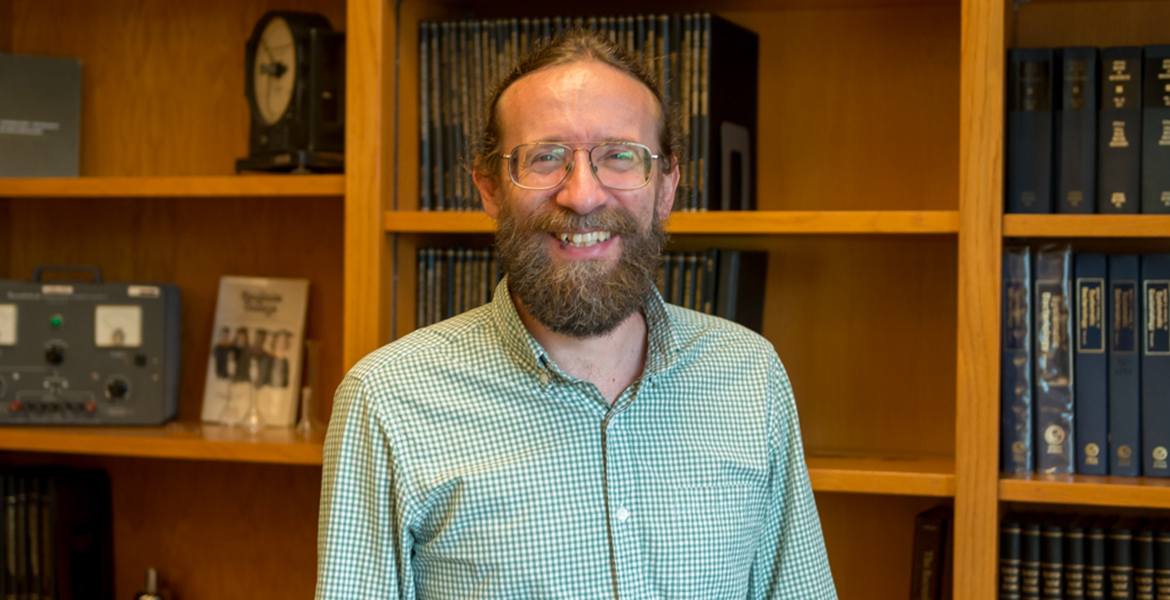
For microbiology professor, it’s all about the little things
Thursday, July 16, 2020
An article co-authored by Dr. Wouter Hoff of the OSU Department of Microbiology and Molecular Genetics was recently published in Nature’s Scientific Reports, a prestigious journal that focuses on advancements in the natural and clinical sciences. Hoff’s research on extreme halophiles—bacteria that thrive in high-salt environments—led to the discovery that certain bacteria are able to switch osmoprotectant strategies.
Osmoprotectant strategies, Hoff explained, are the way that cells adapt to keep from bursting or shriveling up due to molecular imbalances and differing water concentrations inside and outside the cell. For bacteria in extremely salty situations, Hoff said there are two ways to cope: “The glycine betaine strategy and the potassium chloride strategy.”
“What cells do is effectively make the water concentration inside the cell lower by accumulating or producing small molecules,” Hoff said. Some halophiles accumulate potassium chloride from their environment to protect themselves, while others produce glycine betaine—an amino acid derivative—to survive.
“In the past it was thought that an organism was dedicated: either you're a halophile that does the potassium chloride trick or you’re a halophile that does the glycine betaine trick,” Hoff said. “But what was new and exciting in our paper was that we found an organism that can switch between these two strategies.”
“For example,” Hoff said, “depending on what salty lake the bacterium finds itself in, it can adapt. If the lake it’s in happens to have enough potassium in it, in addition to sodium chloride, it will accumulate potassium chloride and it will be osmoprotected. If it happens to fall in a lake where there is very little potassium, OK, no problem. Then it will use the glycine betaine strategy. We call that an osmoprotectant switch.”
Hoff, who has a Ph.D. in microbiology and chemistry from the University of Amsterdam, said his research is usually focused on photoreceptors, or “proteins that allow bacteria to detect light,” so discovering a osmoprotectant switch capability in extreme halophiles was “kind of by accident.” He explained that it was by reflecting on his postdoctoral advisor’s work on photoreceptors in extremely salt-loving halophilic bacteria that he saw “subtle clues” to his latest published research.

Although the results of Hoff’s research cannot be directly applied yet, “applications are not what I'm directly aiming for,” he said. As opposed to applied research that is focused on specific answers to specific problems, Hoff’s research is fundamental, or about discovering the scientific foundations of how things work. “What I'm aiming for is trying to get answers to the most fundamental questions I can think of. The history of science indicates that it's virtually impossible to predict which research will lead to the biggest impacts.”
A fellow professor in the Department of Microbiology and Molecular Genetics, Dr. Noha Youssef, added that it’s through studying the DNA (or genome) of a microorganism that we learn everything it is and everything it can do. “Newer technologies now allow you to do this even when you are not able to grow the bacterium in the lab on a Petri dish,” Youssef said. “You can only imagine the amount of knowledge and power this gives you. New antibiotics, new environmental and ecological roles and new enzymes are just a few examples, but the possibilities are endless.”
Dr. Tyrrell Conway, head of the Department of Microbiology and Molecular Genetics, echoed Hoff’s and Youssef’s points about studying the micro side of science. “It is important to understand how extant microorganisms live in extreme environments because billions of years ago life had to tolerate very harsh conditions,” Conway said. “Each time we learn something new about something potentially very old, we are looking into the natural history of our planet.”
Although Hoff prefers to conduct fundamental research, he also understands the need to fund and perform applied scientific research as well.
“One can look at it as a stock portfolio,” Hoff said. “Applied research is more in the category of low risk, low return. And fundamental research is in the category of high risk, high return. You want to have both in your portfolio.”
When not conducting his fundamental research of choice, Hoff is in the classroom teaching students to pursue a lifetime of learning through critical thinking.
“In my teaching, I place more and more value on intellectual tools,” Hoff said. “Students are presented with all this knowledge, information on how to calculate things and how to answer difficult questions, but what are their intellectual tools for deciding if a scientific statement is worth holding onto, and which statements are suspicious?”
“I'm giving them homework for the rest of their lives,” Hoff continued. “They will forever search for if things are consistent. It's reasonable to think that most of the stuff in that impressive textbook falls into the incomplete category. It's not necessarily wrong, but a lot of it is incomplete. Having these intellectual tools are of tremendous value, both in science and in any other aspect of life.”
Read Hoff’s recent journal article on extreme halophiles at www.nature.com/articles/s41598-020-59231-9.
MEDIA CONTACT: Elizabeth Gosney | College of Arts and Sciences | 405-744-7497 | egosney@okstate.edu
